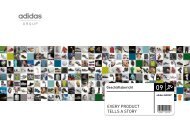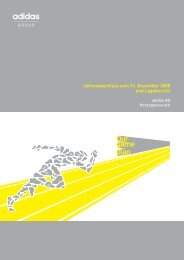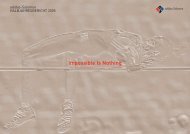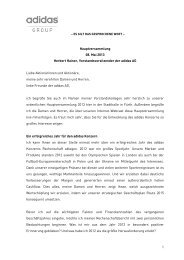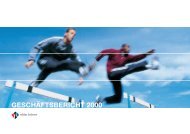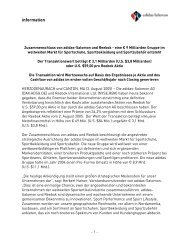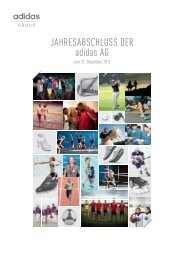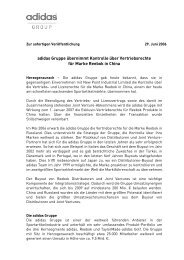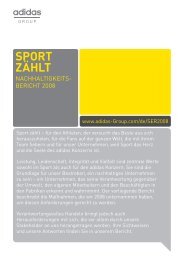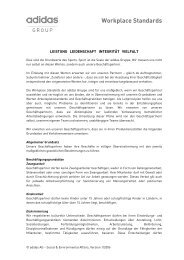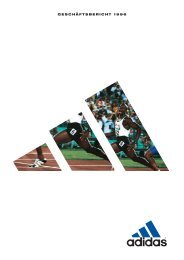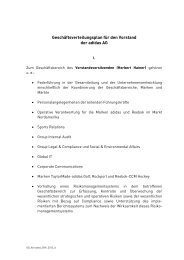Environment PDF - adidas Group
Environment PDF - adidas Group
Environment PDF - adidas Group
Create successful ePaper yourself
Turn your PDF publications into a flip-book with our unique Google optimized e-Paper software.
PRODUCT SAfETY<br />
CONTROLLINg ANd mONITORINg<br />
ReSTRICTed SUBSTANCeS<br />
Restricted substances are those that cause harm or<br />
are suspected to cause harm to human health or the<br />
environment. Our approach is that suppliers must avoid<br />
the use of possible harmful substances to ensure that our<br />
products are environmentally safe.<br />
In 2010, we reviewed and updated our standards and policies<br />
on restricted substances – the A-01 Requirements – to<br />
make sure that they were following state of the art science,<br />
and we were consistently executing them to the highest<br />
standard. We also successfully adjusted our policies and<br />
internal guidelines in keeping with developing requirements<br />
such as the US Consumer product Safety Improvement<br />
Act (CpSIA) and the eU system for Registration, evaluation<br />
and Authorisation and Restriction of Chemicals (ReACH).<br />
New information, amendments and guidance material were<br />
issued and all <strong>adidas</strong> group entities and product divisions<br />
began to implement them.<br />
WHAT OUR mATeRIALS SUppLIeRS mUST dO<br />
materials supplied to the <strong>adidas</strong> group must meet the<br />
strictest local standards globally. We ask our suppliers to<br />
ensure that:<br />
• materials are non-toxic in use and disposal<br />
• Used materials do not cause toxic emissions during the<br />
manufacturing process<br />
• products are manufactured under the best possible<br />
conditions using the best available technology<br />
• materials meet the sourcing standards of retailers,<br />
customer expectations and recommendations from<br />
consumer organisations.<br />
Not only do we regularly consult with scientists and other<br />
experts about new legal requirements, requests from<br />
consumer groups or critical materials, but we also frequently<br />
tell our material suppliers about new scientific findings and<br />
developments. They in return must prove that materials<br />
comply with our standards by providing test reports from<br />
independent external test institutes on a regular basis.<br />
development and production samples are checked randomly.<br />
THe AfIRm WORKINg gROUp<br />
To further strengthen our programmes and benchmark our<br />
achievements, the <strong>adidas</strong> group is an active member in the<br />
Apparel & footwear International Restricted Substances<br />
(RS) management Working group (AfIRm), which we cofounded<br />
in 2004, together with six other international brands.<br />
It is a multi-company working group which provides a forum<br />
to advance the global management of restricted substances<br />
in the apparel and footwear industry, to exchange ideas for<br />
improving RS management to ultimately increase consumer<br />
satisfaction.<br />
01 ABOUT OUR pROgRAmme<br />
17 eNVIRONmeNT<br />
41 SUppLIeRS<br />
57 empLOYeeS<br />
64 COmmUNITY<br />
72 peRfORmANCe<br />
102 gRI INdex<br />
The AfIRm Working group brings together product<br />
chemistry, safety, regulatory, and other experts within the<br />
apparel and footwear industry. during 2010, the AfIRm<br />
Working group held the fourth of its joint supplier workshops<br />
with around 450 participants in Hong Kong. discussions<br />
centred on the further global harmonisation of standards,<br />
extended communication with the scientific community, and<br />
also further interaction to enhance the performance of the<br />
nominated test houses.<br />
pROdUCT SAfeTY fOCUS<br />
Besides ensuring safe and environmental sound products<br />
within our core product ranges, we constantly monitor and<br />
educate branded product areas that may have special risk<br />
profiles. These areas range from promotional items about<br />
bioactive textiles (ones that can interact with living organism)<br />
to personal protective equipment, electronic devices and<br />
traditional kids and baby clothing.<br />
In 2010, our global Operation teams, in consultation with the<br />
SeA team, updated our global Apparel Safety manual for<br />
Children’s Clothing to keep our products safe for this young<br />
and very active consumer group. A similar footwear Kids<br />
Safety manual was also developed and rolled out.<br />
The <strong>adidas</strong> group faces a risk of selling defective products,<br />
which may result in injury to consumers and/or image<br />
impairment. We mitigate this risk by employing dedicated<br />
teams that monitor the quality of our products on all<br />
levels of the supply chain through rigorous testing prior to<br />
production, close cooperation with suppliers throughout the<br />
manufacturing process, random testing after retail delivery,<br />
open communication about defective products and quick<br />
settlement of product liability claims when necessary. In<br />
2010, we did not recall any products.<br />
GREEN PRODUCTS<br />
AdIdAS BeTTeR pLACe<br />
Better place was started in 2007 as an <strong>adidas</strong> brand<br />
initiative to help guide and encourage the creation of more<br />
sustainable products without compromising functional and<br />
quality performance. To do that, the programme tools set<br />
environmental performance benchmarks products need to<br />
qualify for to achieve the Better place standard.<br />
The development of the sustainable product guidelines within<br />
<strong>adidas</strong> – the Better place Apparel, footwear and Hardware<br />
Tools – was a response to the absence of a single global<br />
standard that defines what it meant to create sustainable<br />
products. So the goal was to demand sustainability at the<br />
same level as <strong>adidas</strong> requires of product performance.<br />
In constructing the Tools, existing environmental product<br />
standards, product examples from around the globe,<br />
leading edge materials and construction technologies were<br />
evaluated to establish meaningful and applicable guidance<br />
for designers, developers and materials sourcing for their<br />
decision-making. They also cover <strong>adidas</strong> group mainstream<br />
standards as defined in the <strong>adidas</strong> group’s policy on<br />
restricted substances as well as environmental guidelines<br />
that supplier factories are required to adhere to.<br />
IN THE REAL WORLD PERFORMANCE COUNTS Sustainability Report 2010<br />
30



